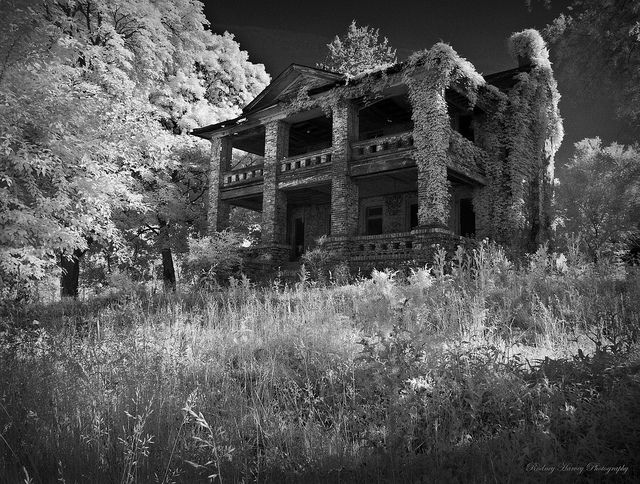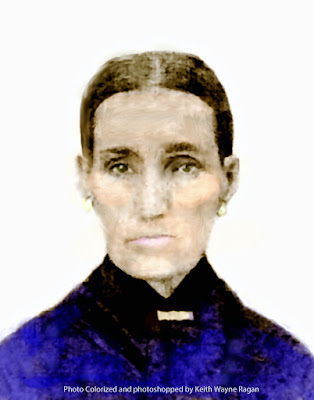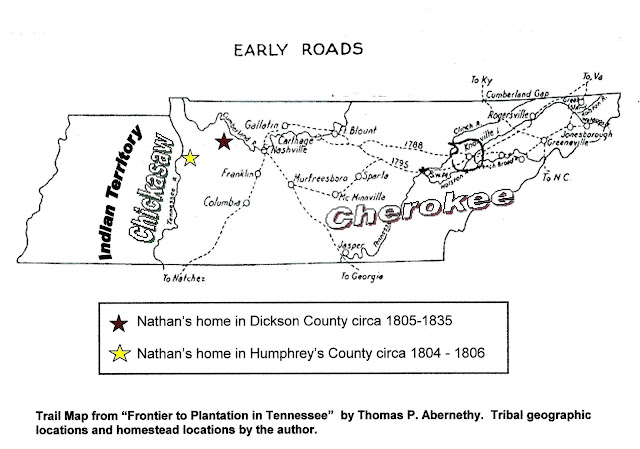OUR TARLTON STORY--PART THREE/Our Tarlton Ancestors in Wayne County, Missouri
OUR
TARLTON GRANDPARENTS IN WAYNE COUNTY, MISSOURI
 |
| Abandoned Estate in nearby Ralls County, Missouri |
OUR TARLTON STORY--PART THREE
So
leaving behind the rawness and danger to his growing family in
Gallatin County, Illinois, between the years 1820 - 1825 General
Azion Tarlton had a good part of his family in Wayne County,
Missouri. There was probably another voyage down the Ohio between
those years of 1820 – 1825, to its confluence with the Mississippi,
then up the Mississippi to Cape Girardeau, Missouri, one of the most
utilized river ports of the day. Or just possibly, but the least
likely, the family may have went to the confluence of the Ohio and
Mississippi rivers in New Madrid, Missouri and came overland on what
was to be called in later years the New Madrid to Greenville Road.
I
still believe the former, and the family may have stayed in that
vicinity for a year or two and one son, James Tarlton definitely did,
as he married Miss Ann Murphy in Cape Girardeau County, in what today is
Marble Hill, Bollinger County, on Christmas day of 1825 before moving
on to Wayne County. Lavina Tarlton, certainly a daughter since this
name continued to be used by this family and their descendents,
married Isaac W. Smith April 30, 1827 in Cape Girardeau County,
Missouri, also.
The
Tarltons in Wayne County, Missouri
On
the 1830 census Azion Tarlton, aged between 50 – 60 years of age,
was already established in Wayne County, Missouri and sons George,
John, and James Tarlton were also transcribed as heads
of household. All four had their names misspelled as Talton by the
transcriber. Maybe this was a mistake on the transcriber’s part,
not used to hearing the southern brogue pronunciation of the family
name.
The
young sons of General Azion Tarlton all were born in the Carolinas.
James was born in North Carolina in 1800 according to the 1850 census
for Wayne County, Missouri. George was probably born in 1804 in York
County, South Carolina and John about 1810, also in York County
(Civil War record and 1850 Wayne County Census). For certain, a
sister of the three brothers, Jane Tarlton, was there in
Zion’s household when he settled into Wayne County as well. The
Jackson Independent Newspaper of Jackson, Missouri, the
county seat for Cape Girardeau County at that time, with an issue
date of June 4, 1825 announced the marriage of Jane Tarlton, daughter
of General Tarlton, to Hugh McGee. There are no census records for
any state that lists a “General Tarlton (Tarleton) prior or after
this timeline, so this Tarlton certainly is General Azion (Zion)
Tarlton as passed down in oral family history. The location of the
marriage was given as McGee, Missouri, which is located in Wayne
County.
Hugh
McGee is found on the 1830 census for Wayne County. Hugh and Jane are
not in Wayne County in 1840, and likely were deceased or relocated.
The town of McGee was named for the McGee family, almost certainly
for Hugh McGee and his brother Thomas Jefferson McGee. Thomas McGee
married Tabitha Cato, so you can see how these families remained
linked through the passing of time. And have more history together in
the ensuing years.
I
hope family interested in their history and origins give some thought
into how new, raw and exciting these times were for our Tarltons. It
was a big land, with many different people. Small bands of Delaware
and Shawnee, many western remnants of Tecumseh’s ravaged tribe,
cohabited with small transient populations of mostly French trappers
and miners. The early settlers were still within striking distance of
the western tribes’ forays for coup, material possessions,
livestock, captives and scalps. In John R. Swanton’s book “The
Indians of the Southeastern United States,” Map 11 shows
that a substantial branch of the Cherokee were still living in the
area as of 1794 and surely some remained thirty years later when Zion
hewed his first log for a dwelling.
France
was the first country to claim and settle in Missouri and did not
cede it to Spain until 1763. Spain eventually relinquished it back to
France in 1800. And of course, in 1803 France sold Missouri to the
United States as part of the Louisiana Purchase. It was the dawn of
possibilities between the years 1820 - 1825 when the Tarlton clans
claimed a portion of Wayne County as their own. They settled on lands
that in later years would be synonymous with our Tarlton clans for
generations to come.
Unlike
most of our other early ancestry making their way to Southeastern
Missouri, our Tarlton Grandparents were a family of means and
prosperity. The original Tarlton home that would come to be known as
a plantation was referred to by writers of early Missouri history as
“a beautiful estate” and was said to have been located about four
miles northeast of the town of Wappapello. It probably did not look
much different from the photo of the abandoned plantation house in
the photo I have attached. That house was located in Ralls County,
Missouri.
This
would have placed the family in the vicinity of the high ground along
the southwest rim of Mingo Swamp in what later would become Jefferson
Township. Using the landmarks of today, that would place them about
four miles northeast of the town of Wappapello on Highway Z on
Stanley Creek. Stanley Creek empties into Mingo Swamp. That land
would be passed on to Zion’s son John (SR) who patented the acreage
in 1853, and after his death, to Francis Womack that married John’s
widow and raised his children. The site of the Womack Cemetery of
today is within the borders of the original Tarlton Plantation.
The
Catos and McGees would settle to the northwest of Mingo Swamp, just
up the road. It is not much of a stretch of my imagination to
envision these families clearing land together, raising buildings,
frolicking during “shuckings” and barn dances, and bowing heads
as one during the circuit preacher’s fervent camp meeting prayer. I
believe Zion Tarlton and his sons carved out a small paradise in
Wayne County. It would have been backbreaking work to clear the land
and plant crops, mostly of Indian corn in the early years. Remember
this was Wayne County, Missouri. A land covered by forests and
swamps.
In
the forest canopies surrounding Mingo Swamp corn would not grow
without sunlight. So, first they “girded” the great trunks of
hickory and oak on the ridges above the cypress and tupelo trees
below, causing the flow of nutrients to cease. The leaves withered
and died and fell to the ground allowing sunlight to warm the earth
underneath for the first time in centuries. Small sustenance gardens
and corn were planted in the rich humus to allow for immediate
survival harvests for family and livestock in those first years. In
the ensuing months fires were built around the dead tree trunks, the
trees felled, and gradually the land of our Tarltons became pastures
and fields of plenty. These descriptions from Cletis Ellinhouse's
book MINGO.
Zion
and sons James, George, and John would have toiled in unison and as
previously conjectured, undoubtedly, neighbors helped out
tremendously as was the custom of the time in the “raising” of
their homes and barns. Women’s’ work would have assuredly started
even earlier than that of the men each day, and would continue into
the darkness of each night as the men found their pipes and chairs in
front of the fire. But, as the grueling days turned into weeks and
months and the months into years, Azion Tarlton, his sons, their
spouses and children would gradually find their lives transformed
into much more prosperous and comfortable means. Their properties are
often referred to as “plantations” in early accounts. And, they
had lived to see their dreams manifested into reality.
General
Azion Tarlton was a man born during the revolution and birth of the
United States. He had taken his family through almost a thousand
miles of wilderness to Wayne County and protected them from every
kind of hardship imaginable. This was not a timid man, but a man of
unbridled spirit with the ability to see past the certainty of his
todays and through the mists into the possibilities of his tomorrows.
His tomorrows had always been in the direction of the setting sun.
His
life is testimony that he was a fearless man. He carved out his own
place to call “my country,” where he could live in peace with
those who settled around him and we know today that that place was in
Wayne County, Missouri. Azion, John, George, and James all appear
still on the 1840 census. George would be from whom we would all
descend (my third great grandfather), as the father of Alexander C.
Tarlton.
Their
last names are spelled variously as John Trlton, Azion Talton, George
Talton, and James Talton. James is separated from the other three
families a short distance and is farming in Cowan Township. I believe
in 1841, aged about 65 - 70 years, General Azion Tarlton, pioneer and
the patriarch of the Wayne County Tarltons, slipped into final rest.
As he took his first immortal step into the light, I have no doubt
that it took him west.
Copyright August 1, 2009 by the author Keith Wayne Ragan and no reproduction in any form may be made without the written consent of the author. It is intended for family files, and may be reproduced for family records.
Author's Footnote for family: General Azion Tarlton was my maternal 4th Great Grandfather: General Azion Tarlton>George Washington Tarlton>Alexander Craig Tarlton>Susan Ann Tarlton Moore>Bessie Edith Moore Wilson>Iva Delores Wilson Ragan>Keith Wayne Ragan.



Do you have any more on the children of Hugh and Jane?
ReplyDeleteTrying to determine if this is the same Hugh McGee that had a daughter Lavinia? And possible a daughter Isabella? Thank you!